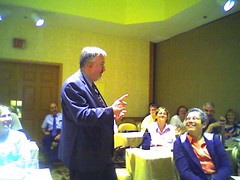OK, the help part first. It’s 3:00 AM. This is not as bad as it sounds. I’m in Arizona and 3:00 AM is the same is 5:00 AM east coast time. So this is actually a good thing, since I reintroduce myself back into eastern standard time tomorrow morning. That’s not the help part. The help part is that it’s 3:00 AM, and the Internet is down, or running extremely slowly — like five minutes to load a page.
I called tech support which was some place on the planet, serving all of the hotels that use RoomLinx. (I must say that I was impressed to see Firefox and Opera among the suggested browsers on the RoomLinx tip sheet.) The support guy asked in which hotel I am staying, and when I responded, “the Westin La Paloma,” he sighed and explained that there is a problem. Someone, in one of the rooms, has a virus on his/her computer, and it is flooding the network, resulting in extremely slow performance. He said that they were working to track down the room, so that they could get the computer disconnected.
Now I know what to tell my K-2 teachers today, when I present to them about contemporary literacy.
Ethics and the new information environment.
It is a measure of how dependent we have become on distant information, that Google is processing a billion searches a day. It means that we’re asking that many questions a day. Since our information infrastructure has become so critical to our prosperity, the ethical use of information has become a critical skill, one that must become an explicit part of what we mean when we talk about literacy.
It really breaks down into three topics:
- Information reliability — Can we rely on the information that we’re using. This means that it is our ethical responsibility to evaluate the information that we use in accordance with the goal that we are trying to achieve. It also means that we are ethically responsible for the information that we publish, assuring its accuracy and reliability.
- Information property — Are we respecting the ownership of information? We are all becoming information property owners, and we expect people to pay us for our information, in either monetary compensation, or simply by crediting us for our work and expertise.
- Information infrastructure — It’s what we live on. It’s the roads and bridges that take us where we want to go, to no less degree than the asphalt roadways outside our homes and places of work. The fact is that planting a virus on a network is no different from planting a bomb under a bridge. They both disrupt our activities, and they can both kill.
None of these topics are really about the technology. They’re about respect. They involve thinking about information in a different way, as a near free flowing raw material with which we answer questions, solve problems, and accomplish goals. We are all readers in this new information environment. But we are also writers, and publishers, artists, and composers. We use information to solve problems and often, that involves working the information. ..and this requires respect — and isn’t that what we teach in kindergarten?
So, I’ll be telling my K-2 teachers today, to teach their students to respect the information. I’ll tell them…
- When they talk about information, always work in where the information came from, who produced it, and why it is reliable
- When they introduce information, include the search process. Show the students the web page — but start with Yahooligans, and include the search process that found the web page.
- When students write something, or draw something, or produce a video or audio something, they should copyright it. Include Copyright (c) by student’s name 2006. Give them the sense of owning information and being responsible for it.
- When bringing community helpers into the classroom, ask them, “How do you use the Internet to save lives?” or, “How do you use e-mail to serve your constituents?”
Information has changed. We live in a time where only a few spammers, virus writers, malicious hackers, and unscrupulous corporate executives, can bring millions of people’s activities to a standstill by abusing information. Ethics and information has to become part of the curriculum.
2¢ Worth!

